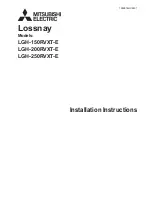
Ріc. 5 Pic. 5.1 Рic. 5.2
6.6 Cooker hood installation VERSION nr. 2
6.6.1
Make a paper pattern with the coordinates of the CDEF holes (Pic. 4), attach the pattern to the
shelves of the furniture set (Pic. 5.1).
6.6.2
Mark and drill 4 holes with Ø6mm drill
6.6.3
Fastening the hood is carried out with 4 metric screws M5x35, which are screwed inside the wall
cabinet into the M5 threaded nuts, riveted to the upper plane of the hood body.
6.7
If necessary, install an air flue nozzle adopter (Ø150 / 120 mm).
6.8
If the hood will work in the mode of exhausting air into the chimney, mount the selected duct with
diameter according to the instructions (Pic. 5.2), ensuring its tightness. Please note that the shorter and more
direct the duct, the higher the performance and less noise and vibration in the hood.
6.9
If the hood will operate in recirculation mode, then the duct is not needed. A carbon odour-absorbing
filter (is purchased separately) must be installed.
6.10
Check that the hood is securely fastened, feed and connect the cord to the mains through the outlet.
In order to provide additional protection against power supply voltage swing, we recommend
connecting the hood through an additional 6A automatic switch.
7. INSTRUCTION FOR USING THE COOKER HOOD
7.1
The cooker hood with sensor switch has 3 speeds of ventilation. Depending on the amount of evaporation
during cooking, you can choose a low, medium or high level of ventilation.
7.2
Before cooking, turn on the cooker hood in the required operation mode. It is recommended to continue
work of the cooker hood for 3-5 minutes after cooking, thus the air in the kitchen will be cleared from the residue
of the vapours and smells.
7.3
On the decorative glass of your cooker hood there is a sensor switch of operation modes of the engine and
lamps of illumination (Pic. 6):
1 speed (law)
-
press switch into position “1”
2 speed (medium)
Pic. 6





































